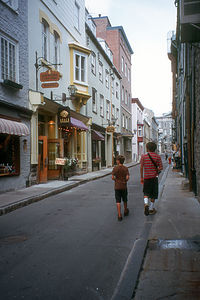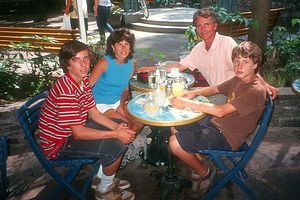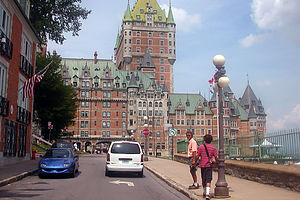- Home
- About
- Map
- Trips
- Bringing Boat West
- Migration West
- Solo Motorcycle Ride
- Final Family XC Trip
- Colorado Rockies
- Graduates' XC Trip
- Yosemite & Nevada
- Colorado & Utah
- Best of Utah
- Southern Loop
- Pacific Northwest
- Northern Loop
- Los Angeles to NYC
- East Coast Trips
- 1 Week in Quebec
- Southeast Coast
- NH Backpacking
- Martha's Vineyard
- Canadian Maritimes
- Ocracoke Island
- Edisto Island
- First Landing '02
- Hunting Island '02
- Stowe in Winter
- Hunting Island '01
- Lake Placid
- Chesapeake
- Provincetown
- Hunting Island '00
- Acadia in Winter
- Boston Suburbs
- Niagara Falls
- First Landing '99
- Cape Hatteras
- West Coast Trips
- Utah Off-Roading
- Maui
- Mojave 4WD Course
- Colorado River Rafting
- Bishop & Death Valley
- Kauai
- Yosemite Fall
- Utah Off-Road
- Lost Coast
- Yosemite Valley
- Arizona and New Mexico
- Pescadero & Capitola
- Bishop & Death Valley
- San Diego, Anza Borrego, Joshua Tree
- Carmel
- Death Valley in Fall
- Yosemite in the Fall
- Pacific Northwest
- Utah Off-Roading
- Southern CA Deserts
- Yosemite & Covid
- Lake Powell Covid
- Eastern Sierra & Covid
- Bishop & Death Valley
- Central & SE Oregon
- Mojave Road
- Eastern Sierra
- Trinity Alps
- Tuolumne Meadows
- Lake Powell Boating
- Eastern Sierra
- Yosemite Winter
- Hawaii
- 4WD Eastern Sierra
- 4WD Death Valley +
- Southern CA Deserts
- Christmas in Tahoe
- Yosemite & Pinnacles
- Totality
- Yosemite & Sierra
- Yosemite Christmas
- Yosemite, San Diego
- Yosemite & North CA
- Seattle to Sierra
- Southwest Deserts
- Yosemite & Sierra
- Pacific Northwest
- Yosemite & South CA
- Pacific Northwest
- Northern California
- Southern Alaska
- Vancouver Island
- International Trips
- Index
- Tips
- Books
- Photos/Videos
- Search
- Contact
Quebec City, QB
Friday, July 30, 2004 - 3:30am by Lolo
166 miles and 3.5 hours from our last stop - 1 night stay
Travelogue
The one thing that makes me feel a bit of a fraud in calling myself a seasoned traveler is the fact that I’ve never once stepped foot off the North American continent. Do I regret it? Sure I do, and someday (probably after the kids are gone) I’m going to make sure I see a lot more of the world, even though it means leaving our beloved Lazy Daze behind. In the meantime, Quebec City was the closest thing I was going to get to the spirit and feel of Old World charm.
 Boy's on streets of Quebec CitySince visiting cities in a motorhome can often be quite stressful, I made sure ahead of time that we would be able to park the RV somewhere safely. In fact, my research actually began in Newfoundland when I overheard a Gros Morne park ranger say that she lived in Quebec City in the wintertime. She was quite helpful (as everyone in Newfoundland is) and drew me a detailed map of Lower Town, marking the large parking lot next to the Musee de la Civilisation on Dalhousie Street. It really does help to get local knowledge.
Boy's on streets of Quebec CitySince visiting cities in a motorhome can often be quite stressful, I made sure ahead of time that we would be able to park the RV somewhere safely. In fact, my research actually began in Newfoundland when I overheard a Gros Morne park ranger say that she lived in Quebec City in the wintertime. She was quite helpful (as everyone in Newfoundland is) and drew me a detailed map of Lower Town, marking the large parking lot next to the Musee de la Civilisation on Dalhousie Street. It really does help to get local knowledge.
Despite my map and preparation, we managed to miss the turn into the parking lot and wound up on a narrow cobblestone side street where we almost became a permanent fixture. This made Herb a little cranky and brought back visions of the time I navigated him into the same situation in Salem, Massachusetts. For some reason I’m able to navigate us across an entire continent, but mess up on the details. Anyway, we did manage to get back to the parking lot without much further ado.
The first place we wanted to explore was Vieux Quebec, the walled portion of the city, which was sat atop the steep cliff rising from Lower Town. Having had so much success with talking to locals in Newfoundland, I decided to use the same approach here in finding the best way to get to Upper Town. Unfortunately, there was a bit of a language barrier—practically everyone spoke only French. I tried to get the boys to practice their French, but all I could get out of them was “No parle Francais.” Big help they were. After a few more unsuccessful attempts with passersby, we resorted to our map to find our own way.
 Quebec City Faux BuildingsWe walked up a steep street that led us through a Gate and onto the Terrasse Dufferin, a pedestrian-only promenade along the cliff’s edge. From there we could look out over Lower Town, from which we had just come, and the St. Lawrence River. The boardwalk was full of activity—street performers playing music and vendors selling their wares from booths that ran the whole length of the boardwalk.
Quebec City Faux BuildingsWe walked up a steep street that led us through a Gate and onto the Terrasse Dufferin, a pedestrian-only promenade along the cliff’s edge. From there we could look out over Lower Town, from which we had just come, and the St. Lawrence River. The boardwalk was full of activity—street performers playing music and vendors selling their wares from booths that ran the whole length of the boardwalk.
The kids and I became quite pouty when we saw happy tourists emerging onto the promenade from the funicular terminal. What the heck was a funicular and why weren’t we one of the happy tourists getting off of it? Perhaps if the boys had spoken French in Lower Town, we would have known about this. Anyway, for whatever reason, we missed out on entering Upper Town via a glass-enclosed gondola-like car along a very steep railway track. I just hate when this happens.
Since we had no particular agenda, we spent the afternoon wandering around the narrow cobblestone streets, taking in the various sights along the way. Right behind the Terrasse Dufferin was my personal favorite—the Chateau Frontenac, a majestic castle that serves as the symbol of Quebec City. It’s actually a hotel and has hosted such dignitaries as Queen Elizabeth, Winston Churchill, and Franklin Delanor Roosevelt. I wish it could have hosted me.
 A refreshing break at La Lapin Saute CafeAfter seeing the main highlights, like La Citadelle and La Basilica de Notre-Dame, we wandered off the main drag into the residential section of the town. This is what I really enjoy—seeing the real city, not just the part marketed to tourists. We eventually wound up along des Ramparts, where cannons lined the fortified walls above Lower Town.
A refreshing break at La Lapin Saute CafeAfter seeing the main highlights, like La Citadelle and La Basilica de Notre-Dame, we wandered off the main drag into the residential section of the town. This is what I really enjoy—seeing the real city, not just the part marketed to tourists. We eventually wound up along des Ramparts, where cannons lined the fortified walls above Lower Town.
We followed the cannons back around to a park near the gate where we first entered the walled city. From there we could look down into the Lower Town and onto one of my favorite sights—a 900 square foot mural depicting the history of Old Quebec, painted on the wall of a building on the rue du Petit-Champlain.
From there we headed down the aptly named “Breakneck Stairs” into the Quartier Petit Champlain, one of the oldest and narrowest streets in North America. It was extremely hot out and we were getting a bit cranky, so we stopped at an outdoor cafe, named La Lapin Saute, for some iced coffee and desserts. It was the perfect thing to cheer us up. Having difficulty deciding which of the delicious desserts to order, we decided to each order something different and then share it. Herb ordered the cheese cake, I ordered the chocolate mousse, Andrew went for the apple pie, and Tommy bravely ordered the creme brulee. Of course, when the desserts arrived and were tasted, all previously established rules went out the window and those that received a dessert they truly enjoyed refused to share it. We were obviously nearing the end of a very long vacation together.
It was getting late in the afternoon and time for us to find a place to spend the night. We had all truly enjoyed our visit to Vieux Quebec, probably even more than we had anticipated. Although not a replacement for visiting Europe, it was the next best thing this side of the Atlantic.
Description
Quebec City, located along the St. Lawrence River about three hours east of Montreal, provides Old World charm without every having to leave the continent. The city is almost entirely French in spirit and language, although you will find a few people, especially those in the tourist trade, that do speak a bit of English.
 Approach to Quebec CityThe city became the birthplace of French civilization in North America when Samuel de Champlain built the first permanent French settlement here in 1608. Because of the importance of its history, its unique beauty, and the fact that it is the only walled city north of Mexico, the historic section of the city was designated a UNESCO World Heritage Site in 1985.
Approach to Quebec CityThe city became the birthplace of French civilization in North America when Samuel de Champlain built the first permanent French settlement here in 1608. Because of the importance of its history, its unique beauty, and the fact that it is the only walled city north of Mexico, the historic section of the city was designated a UNESCO World Heritage Site in 1985.
The city is divided by steep cliffs into an Upper Town (Haute Ville), which is perched on top of Cape Diamond, and a Lower Town (Basse Ville) at the base of the cliffs. Both areas have old and new sections. The two towns are connected by steep ramp-like streets, steep staircases with names such as "breakneck stairs", and a cliff-side elevator called a funicular.
Some logistics before visiting the city:
- Stop at the large Visitor Center located right off Route 73 to obtain maps and information
- When visiting the city, park at the large lot next to the Musee de la Civilisation on Dalhousie street in Lower Town. The lot can accommodate RVs.
Visiting Upper Town (Haute Ville)
Upper Town, which sits atop Cape Diamond, is home to the most visited part of Quebec City, the charming, walled Old Town of Vieux Quebec. Although very hilly, Vieux Quebec is quite compact and best explored by wandering on foot along its cobblestone streets. Wandering through the old town is like wandering through an old European city. Maps of the old city and recommended walking tours can be obtained at one of the visitor centers or gifts shops in the area.
A good place to start your walk is at the Terrasse Dufferin, a pedestrian-only promenade along the cliff's edge overlooking the river, filled with street vendors and performers. From there, it is a short stroll to many interesting sights, such as:
- Chateau Frontenac - majestic castle atop Cape Diamond, which serves as the symbol of Quebec City. Built in 1893, this restored hotel has hosted such guests as Queen Elizabeth, Winston Churchill, and Franklin Delanor Roosevelt.
- Les Glissades de la Terrasse - a 270 feet high and 630 feet long slide on which you can ride a specially built toboggan, which reaches speeds of up to 60 mph.
- Basilica of Notre-Dame - the oldest Christian parish north of Mexico. Originally built in 1647, it was destroyed twice by fire and rebuilt. The Cathedral contains many impressive works of art.
- La Citadelle - star-shaped fort, which is now home to a military museum and the Royal 22e regiment. There are tours of the grounds and buildings as well as a changing of the guard ceremony.
- Parc des Champs-de-Bataille (Battlefields Park) - 270 acres of gardens, fountains, monuments, and trees where Quebecois come to relax and enjoy the outdoors. The park stretches over the Plains of Abraham, the site of a 1759 British victory over the French.
- Musee de Quebec - art museum that now occupies two buildings, one a former prison, linked together by a soaring glass-roofed "Grand Hall" housing a cafe and gift shop
Visiting Lower Town (Basse Ville)
The Lower Town is located at the base of Cape Diamond. It was here that the first French settlers lived before moving to safer houses atop the steep cliffs in order to avoid British gunfire.
"Breakneck stairs" leads down from Terrasse Dufferin in Upper Town to the restored Quartier du Petit-Champlain in Lower Town. The cobblestone Rue du Petit Champlain that runs through the Quartier is one of the oldest and narrowest streets in North America. It is lined with unique stone houses, churches, lovely squares, and numerous boutiques and outdoor cafes. One of the more interesting sights in the Quartier is a 900 square foot mural depicting the history of the area. It is painted on the side of a building at 102 rue du Petit-Champlain. There is an excellent view of the mural from the cannons in the park in Upper Town.
East of the Quartier du Petit-Champlain is Place Royale, a picturesque plaza that is the spiritual heart of Lower Town. During the 1600s, this plaza served as the town marketplace for the first permanent settlement in New France. After 1860, the use of the square declined and it became a run-down part of town. Today it has been restored to recapture its 400 years of history. Surrounding the square are 17th century houses that once belonged to wealthy merchants. Dominating the square is the Eglise Notre-Dame-des-Vicoites, the oldest stone church in Quebec. Suspended from the ceiling of this church is a large model boat, which served as an offering to ensure safe sea voyages. The church is open to visitors. The Interpretive Center at the northeast corner of the square conducts free guided tours of the plaza.
Another "must see" in Lower Town is the Musee de la Civilisation, one of Canada's most innovative museums. The dramatic atrium-lobby contains a massive sculpture of icebergs rising out of the floor. In the galleries above are five permanent exhibits and six temporary ones. If you only have time for one exhibit, make it "Memoires," which chronicles the history of Quebec, from its roots as a fur-trading colony to the present.
- ‹ previous
- 22 of 23
- next ›
Quebec City location map in "high definition"
Javascript is required to view this map.

Look, if you stopped at a Visitors' Centre in Wetaskawin, Alberta, no one would speak French.
Hello, first thing thanks for all the time you take to share your knowledge!!!
So I am a RV person and I live in Quebec City. One thing i noticed is that you mapped that you went to sleep at the Koa out of town. All the traveler should know that you can spend the night in the Marina right down town. It's a regular parking lot, but a lot of RV spend week-end there (it's aloud) and I think the rate is around 30$-40$. No services but very prime location! The view is incredible, you are right in Vieux Québec and no need for a car since everything is within walking distance... And if you are tierd of walking at the end of the day you are right on the free bus line that desserve Vieux Québec.
And one more thing, plan more than a day in Québec City since their so much free amasing activities during summer time. We have a FREE Cirque du Soleil presentation outdoor every night!!! Plus "Le moulin à images" also free and everynight (check on internet), plus all the festivals. And no need to worry for security, Québec City is extra safe! Their is like 2 police car in charge of the whole town at night, virtually nothing bad ever happends; most people do not even lock their doors.
And to everyone, do not hesitate to contact me if you plan a trip to Québec City, it will be a pleasure to give you some tips!
Sophie, Sophielez@hotmail.com
(please excuse my english... I am french)
Wow! That's a lot of great information about RVing in Quebec City. We are usually hesitant to visit cities in the RV because it's often difficult to maneuver and park. We were just up in Quebec province a few weeks back. If we had known about the Marina to camp at and the Free Cirque du Soleil presentations, we definitely would have paid another visit to Vieux Quebec. Thanks for the great advice and we'll get in touch when we plan to visit again. P.S. Your English is 10 times better than my French.